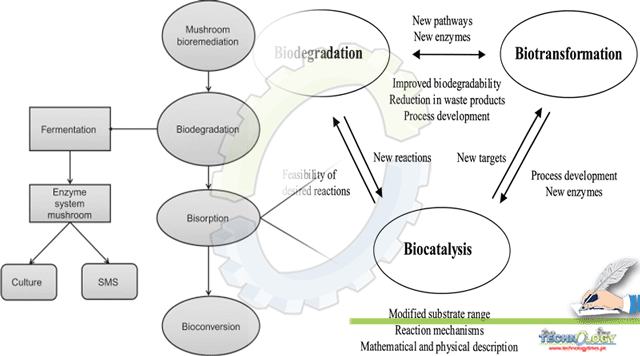By Samra Gulzar, Athar Mahmood, Maria Naqvi
Biodegradation is the disintegration of materials by bacteria, fungi, or other biological means.This term is often in natural environment in relation to biomedicine, waste management, ecology, and the bioremidiation.

Introduction:
These are so numerous and diverse that a huge range of compounds can be biodegraded, including hydrocarbons (oils), polycyclic aromatic hydrocarbons (PAHs), polychlorinated biphenyls (PCBs) and pharmaceutical substances. Microorganisms secrete biosurfactant, an extracellular surfactant, to enhance this process.
History:
In 1961 the first known use of the world in biological text when employed to describe the micro organisms used to breakdown of the base component of carbon, hydrogen and oxygen.
Biodegradation Phase:
The process of biodegradation happens naturally over time. With plastic, this process usually takes hundreds of years to complete, if ever, because of strong polymer that makes up its chemical structure. EcoPure plastic complete the biodegradation process at much higher rates, which includes;
Aerobic Phase:
In this phase, the enzymes and decomposition chemicals act as a catalyst to the biofilm coating the plastic. During this time, aerobic microbes are becoming established and moisture is building up in the refuse. The aerobic biodegradation process in which oxygen is converted to carbon-dioxide which creates microbial growth.
Anaerobic Phase:
After oxygen concentrations have declined sufficiently, the anaerobic processes begin. During the initial stage (hydrolysis), the microbe colonies eat the particulates, and through an enzymatic process, reduce large polymers into simpler monomers. This further excites the microbes to increase their colonization and consumption of the polymer chain. Simple monomers are converted into fatty acids so acidogenesis occurs as the time progresses CO2 production occurs rapidly at this stage.
Anaerobic, Methanogenic Unsteady Phase:
During this phase acetogenesis occurs, converting fatty acids into acetic acid, carbon dioxide and hydrogen. As this process continues, CO2 rates decline and hydrogen production eventually ceases.
Anaerobic, Methanogenic Steady Phase:
The final stage of decomposition involves methanogensis. As colonies of microbes continue to eat away at the remaining surface of the polymer, acetates are converted into methane and carbon dioxide, and hydrogen is consumed. The process continues until the remaining element is humus.
Types of biodegradation
1. Aerobic biodegradation
Aerobic biodegradation is the breakdown of organic contaminants by microorganisms when oxygen is present. Many organic contaminants are rapidly degraded under aerobic conditions by aerobic bacteria called aerobes. Aerobes, in a process known as cellular respiration, use oxygen to oxidize substrates(for example sugars and fats) in order to obtain energy.
2. Anaerobic biodegradation
The digestion process begins with bacterial hydrolysis of the input materials in order to break down insoluble organic polymers such as carbohydrates and make them available for other bacteria. Acetogen then convert the sugars and amino acids into CO2, Hydrogen, ammonia, and organic acids. Acetogenic bacteria then convert these resulting organic acids into acetic acid, along with additional ammonia, Hydrogen and carbon dioxide. Methanogen finally are able to convert these products to methane and carbon dioxide. There are 4 key biological and chemical stages of anaerobic biodegradation.
Hydrolysis:
Constituent parts or monomers such as sugars are readily available by other bacteria. The process of breaking these chains and dissolving the smaller molecules into solution is called Hydrolysis. Therefore in anaerobic degradation, Through hydrolysis complex organic molecules are broken down into simple sugars, amino acids, and fatty acids. Other molecules such as volatile fatty acids (VFA’s) with a chain length that is greater than acetate must first be catabolized into compounds that can be directly utilized by methanogens.
Acidogenesis:
The biological process of acidogenesis is where there is further breakdown of the remaining components by acidogenic (fermentative) bacteria.
Acetogenesis:
The 3rd stage anaerobic digestion acetogenesis. Here simple molecules created through the acidogenesis phase are further digested by acetogens to produce largely acetic acid as well as CO2 and hydrogen.
Methanogenesis:
Here methanogens utilize the intermediate products of the stages and convert them into methane, carbon dioxide and water.
Factors affecting biodegradation rate:
A number of factors determine the rate at which this degradation of organic compounds occurs. Salient factors include light, water and oxygen. Temperature is also important because chemical reactions proceed more quickly at higher temperatures. Many organic compounds have limited rate of degradation by their bioavailability. Before compounds degraded by organisms they must be released into solution. In a number of ways biodegradability can be measured.
Drawbacks:
Oils from shallow, cool reservoirs tend to be progressively more biodegraded than those in deeper, hotter reservoirs. Increasing levels of biodegradation generally cause a decline in oil quality, diminishing the producibility and value of the oil and distillate yields decrease. Additionally, viscosity, sulfur, metals and total acid numbers increase. Prediction of oil quality difficult in some areas. It does not remove all quantities of contaminents.
Benefits:
Biodegradation can help bring an ecosystem back to its original state. Toxic chemicals are destroyed. It is cost effective.
Conclusion:
Biodegradation and now this is one of the best way that many country use to protect environment from harmful material, waste material
Many of this successful way we can use like: Warning people to use less harmful material and use more useful material that is good for nature. There are some ways to use scientific material in a healthy. Repair, Reuse, Reduce, and Recycle.
Authors : Samra Gulzar, Athar Mahmood, Maria Naqvi